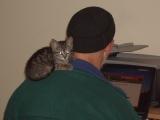Istanbul
After a late night and lots of rakı New Year’s Eve, Nur and I caught the 7AM bus to
On Tuesday, we caught the ferry to Büyükada ‘
On Wednesday, they reopened Topkapı Sarayı ‘Artillery-Gate Palace’. I had never been there before. There was quite a forbidding queue to get in to the Harem section, so we just wandered around the less crowded galleries of the Treasury. It’s quite amazing how they get all those little pieces of diamonds and rubies and emeralds and stuff to fit together into patterns to decorate the sultan’s water bottle. What’s even more amazing is that people would spend their brief, miserable lives destroying their eyesight doing that kind of stuff for their oppressors. I can hardly imagine what kind of conditions the sultan’s jewelers must have worked under.
I once read this novel, My name is red, by Orhan Pamuk – he got the Nobel Prize for it. It’s quite a strange novel, in my limited experience of reading fiction. It’s kind of a mystery about the murder of some of the sultan’s manuscript illuminators, all narrated in the first person by a wide range of characters, including a sketch of a tree and the colour red, whence the title. There’s a lot of deliberation over whether an illuminator should allow any trace of individuality to creep into his (yes, always his) work. A difference of opinion over this momentous question appears to have been the motive. Anyway, Pamuk describes how he imagines life must have been like for those guys, and I’m sure he comes a lot closer than I could. Now doubtless paper and ink and the gold leaf and stuff they used for the illumination were real precious and all, but I expect those actually working in gold and jewels would have been outright prisoners.
I guess jeweled water bottles and ornate ceilings don’t quite fit into my aesthetic.




No comments:
Post a Comment